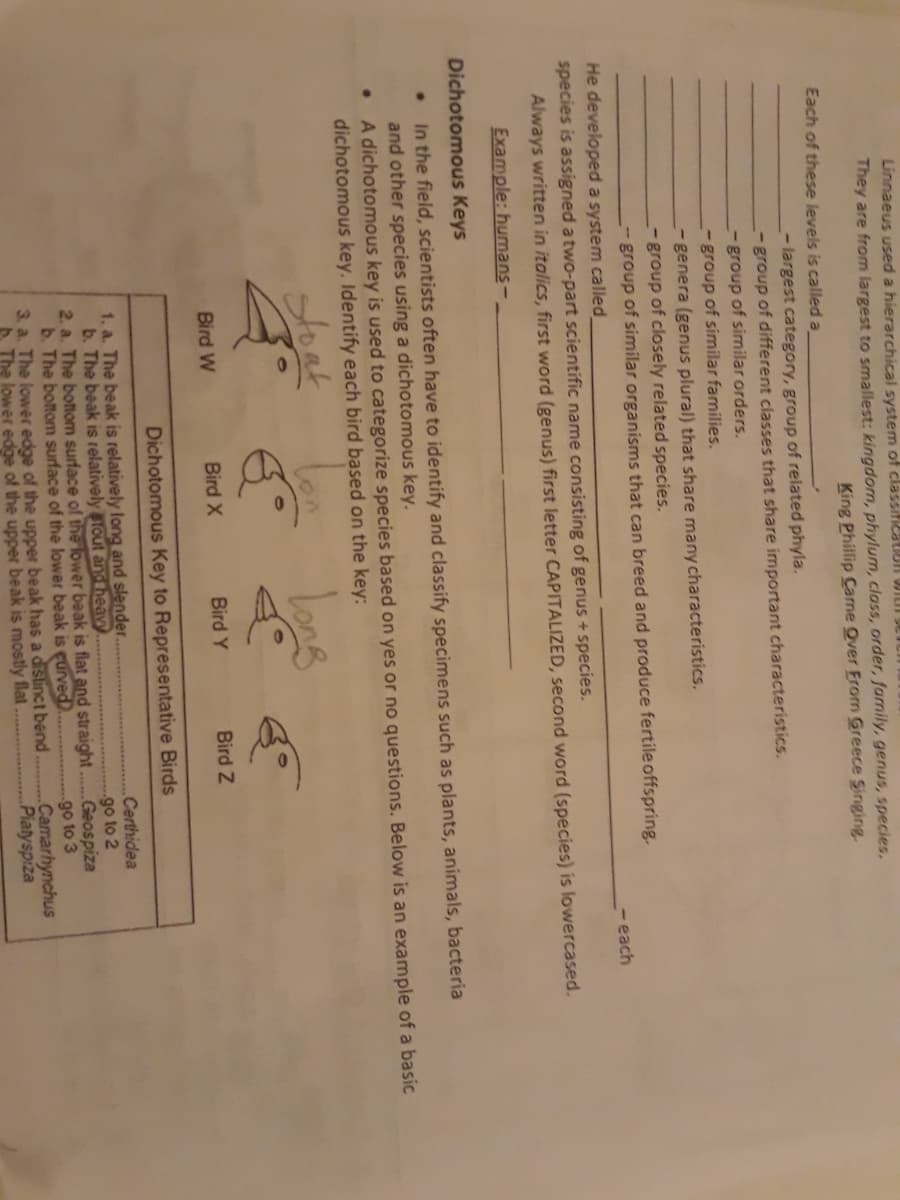They are from largest t8 SHidilesL. K King Phillip Carne Qver Erom Greece Singing. Each of these levels is called a -largest category, group of related phyla. - group of different classes that share important characteristics. - group of similar orders. - group of similar families. -genera (genus plural) that share many characteristics. - group of closely related species. - group of similar organisms that can breed and produce fertile offspring. He developed a system called species is assigned a two-part scientific name consisting of genus + species. Always written in italics, first word (genus) first letter CAPITALIZED, second word (species) is lowercased. each Example: humans-
They are from largest t8 SHidilesL. K King Phillip Carne Qver Erom Greece Singing. Each of these levels is called a -largest category, group of related phyla. - group of different classes that share important characteristics. - group of similar orders. - group of similar families. -genera (genus plural) that share many characteristics. - group of closely related species. - group of similar organisms that can breed and produce fertile offspring. He developed a system called species is assigned a two-part scientific name consisting of genus + species. Always written in italics, first word (genus) first letter CAPITALIZED, second word (species) is lowercased. each Example: humans-
Human Anatomy & Physiology (11th Edition)
11th Edition
ISBN:9780134580999
Author:Elaine N. Marieb, Katja N. Hoehn
Publisher:Elaine N. Marieb, Katja N. Hoehn
Chapter1: The Human Body: An Orientation
Section: Chapter Questions
Problem 1RQ: The correct sequence of levels forming the structural hierarchy is A. (a) organ, organ system,...
Related questions
Question

Transcribed Image Text:Linnaeus used a hierarchical system of classificatiol WILDI
They are from largest to smallest: kingdom, phylum, class, order, family, genus, species,
King Phillip Carne Qver Erom Greece Singing.
Each of these levels is called a
- largest category, group of related phyla.
- group of different classes that share important characteristics.
- group of similar orders.
- group of similar families.
- genera (genus plural) that share many characteristics.
-group of closely related species.
- group of similar organisms that can breed and produce fertile offspring.
He developed a system called
-each
species is assigned a two-part scientific name consisting of genus +species.
Always written in italics, first word (genus) first letter CAPITALIZED, second word (species) is lowercased.
Example: humans-.
Dichotomous Keys
In the field, scientists often have to identify and classify specimens such as plants, animals, bacteria
and other species using a dichotomous key.
A dichotomous key is used to categorize species based on yes or no questions. Below is an example of a basic
dichotomous key. Identify each bird based on the key:
toat
long
Bird W
Bird X
Bird Y
Bird Z
Dichotomous Key to Representative Birds
1. a. The beak is relatively long and slender.
b. The beak is relatively tout andtheavy
2. a. The bottom surface of the lower beak is flat and straight
b. The bottom surface of the lower beak is curved
3. a. The lower edge of the upper beak has a distinct bend
A. The lower edge of the upper beak is mostly flat
Certhidea
go to 2
Geospiza
go to 3
Camarhynchus
Piatyspiza
Expert Solution
This question has been solved!
Explore an expertly crafted, step-by-step solution for a thorough understanding of key concepts.
Step by step
Solved in 2 steps with 1 images

Knowledge Booster
Learn more about
Need a deep-dive on the concept behind this application? Look no further. Learn more about this topic, biology and related others by exploring similar questions and additional content below.Recommended textbooks for you

Human Anatomy & Physiology (11th Edition)
Biology
ISBN:
9780134580999
Author:
Elaine N. Marieb, Katja N. Hoehn
Publisher:
PEARSON

Biology 2e
Biology
ISBN:
9781947172517
Author:
Matthew Douglas, Jung Choi, Mary Ann Clark
Publisher:
OpenStax

Anatomy & Physiology
Biology
ISBN:
9781259398629
Author:
McKinley, Michael P., O'loughlin, Valerie Dean, Bidle, Theresa Stouter
Publisher:
Mcgraw Hill Education,

Human Anatomy & Physiology (11th Edition)
Biology
ISBN:
9780134580999
Author:
Elaine N. Marieb, Katja N. Hoehn
Publisher:
PEARSON

Biology 2e
Biology
ISBN:
9781947172517
Author:
Matthew Douglas, Jung Choi, Mary Ann Clark
Publisher:
OpenStax

Anatomy & Physiology
Biology
ISBN:
9781259398629
Author:
McKinley, Michael P., O'loughlin, Valerie Dean, Bidle, Theresa Stouter
Publisher:
Mcgraw Hill Education,

Molecular Biology of the Cell (Sixth Edition)
Biology
ISBN:
9780815344322
Author:
Bruce Alberts, Alexander D. Johnson, Julian Lewis, David Morgan, Martin Raff, Keith Roberts, Peter Walter
Publisher:
W. W. Norton & Company

Laboratory Manual For Human Anatomy & Physiology
Biology
ISBN:
9781260159363
Author:
Martin, Terry R., Prentice-craver, Cynthia
Publisher:
McGraw-Hill Publishing Co.

Inquiry Into Life (16th Edition)
Biology
ISBN:
9781260231700
Author:
Sylvia S. Mader, Michael Windelspecht
Publisher:
McGraw Hill Education